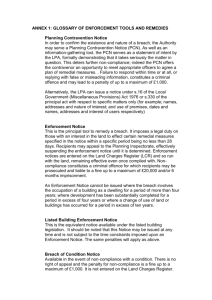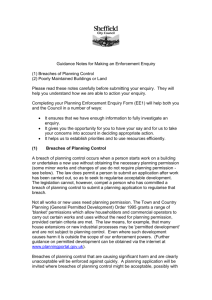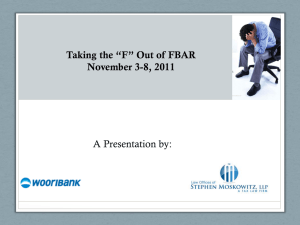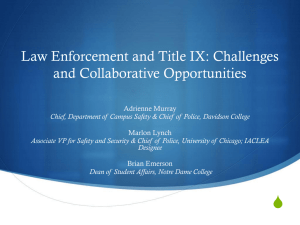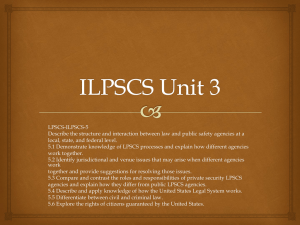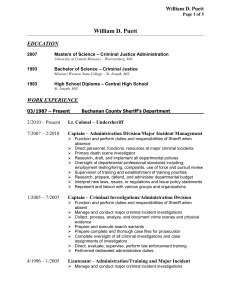Investigations and enforcement - Environment Institute of Australia
advertisement
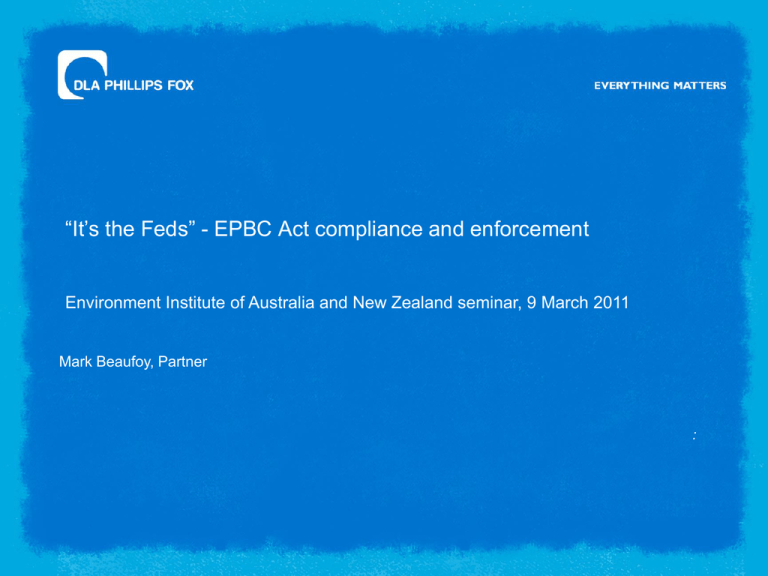
“It’s the Feds” - EPBC Act compliance and enforcement Environment Institute of Australia and New Zealand seminar, 9 March 2011 Mark Beaufoy, Partner : Outline • Key legal issues • SEWPaC investigation and enforcement powers • Incident response • Conclusions EPBC Act - key legal issues • ‘significant impact’ on ‘matter of national environmental significance’ (MNES) • Key MNES - threatened species and ecological communities, migratory species, RAMSAR wetlands • Referral to Commonwealth Environment Minister for determination on ‘controlled action’ - will or likely to have a ‘significant impact’ on MNES (what if not likely?) • Note internal review of controlled action decision available (s.78), judicial review and injunctions in Federal Court - actions by environmental interest groups (but undertaking as to damages and costs may be awarded) EPBC Act – key legal issues (cont.) • ‘Principal’ under contract is person responsible for referring action / compliance with the Act (s.68A) • party to contract etc for whose benefit the action is proposed to be taken • person who requested, procured, etc the contract and is to be responsible for controlling and directing the taking of the action • If controlled action and approval, it is a condition of the approval that the principal must ‘take all reasonable steps’ to ensure contractors are aware of approval conditions and comply with conditions that restrict or regulate the way in which the action is undertaken (s134(1A)) EPBC Act – key legal issues (cont.) • Penalty provisions / offences • • • • • • • significant impact on MNES (s.18, 18A, etc) taking action before decision made on a referral (s.74AA) breach of particular manner notice (s.77A) non-compliance with condition of approval (s.142) breach of conditions on approval – recklessness and significant impact (s.142A) strict liability for breach of conditions (s.142B) Significant maximum civil and criminal penalties (up to $5.5M for corporation; $500,000 for an individual, up to 7 years imprisonment) EPBC Act – key legal issues (cont.) • Executive officer liability – civil and criminal (s.495, s.495), ‘all reasonable steps to prevent the contravention’ (s.496) • • • • • • regular professional assessments of compliance implements recommendations from assessments appropriate system for managing effects of activities on environment employees, agents and contractors have reasonable knowledge and understanding of requirements for compliance action taken by officer when non-compliance discovered Liability of landholders for other peoples actions – civil and criminal (s.496B, s.496C), ‘all reasonable steps to prevent the contravention’ (s.496D) • • action taken to ensure that actor (e.g. lessee or licensee) had appropriate system for managing effects of activities on environment action taken when landholder became aware that there is a substantial risk that the acting was not complying Investigation and enforcement powers Investigation •Notice to produce information, documents, etc (s.486F) •Notice to attend interview (s.486G) privilege against self-incrimination (s.486J) – note ‘invitation’ to attend an interview cf. notice •Modified •Written request seeking consent for officers to enter premises, often accompanied by ecologists (s.405), production of written identification – if consent not provided or revoked, then monitoring and search warrants from magistrate (again cooperation important) •Powers when entering premises - inspect, photo, video, copy documents, take samples, seizure Investigation and enforcement powers (cont.) Enforcement •Administrative measures - e.g. cautions, warning letters, infringement notices, suspending/revoking approvals, enforceable undertakings remedies – civil pecuniary penalties (lower burden of proof), fines, injunctions, courts orders to repair or mitigate damage •Civil •Criminal penalties - criminal record, fine and/or imprisonment •Note Compliance & Enforcement Policy (1 December 2009) - factors to determine response • • • • nature and severity of harm the law (evidence collected, precedent) integrity of regulatory system (prevalence of contravention, public concern, efficacy of proposed response) any aggravating or mitigating circumstances (malice, culpability, commercial value, record, self-report, cooperation) Incident response Immediate response • Proactive response – quickly engage an expert to understand potential damage, mitigation, remediation options (assessment of ‘significance’) • Consider self-reporting, cooperate with inspectors / officers Internal investigation • Who should be involved in investigations? Consider legal professional privilege (LPP) • What happened to EMS / EMP? • Engage experts to ‘shadow’ regulator investigations / site inspections • Consider LPP in engaging expert (also ‘common interest’ privilege if more than one party – e.g. employee, executive officer, related company) Incident response (cont.) Request for documents and interview • Carefully review requests for documents / information – notice legally correct, comply with timelines, review and assess documents for LPP • Consider potential individual liability of executive officers and employees - do they need separate legal representation? Consider common interest privilege • ‘Invitation’ to interview – is a notice required? Consider privilege against self incrimination • Legal representation during regulator interview - fair questions, within knowledge/expertise, privilege Conclusions Due diligence • For any project, early and quality due diligence is essential • • • • If a significant impact is likely, then refer (even if not likely, consider referral) Can make a significant difference in project approval and construction timing Proper and early understanding of limitations arising from existence of protected matters, can influence design, staging of works and encourage innovative outcomes Avoid breach - investigation and enforcement process can be expensive and time consuming Investigations and enforcement • SEWPaC, DSE and Councils not taking breaches lightly • • • active and resourced investigations and enforcement need to properly advise and supervise contractors (breaches / incidents may also result in contract delay claims) If breach, ensure rapid and quality investigation and remedial response and cooperation with regulators (while exercising and protecting legal rights) Questions and contact Mark Beaufoy, Partner mark.beaufoy@dlaphillipsfox.com T: 03 9274 5377 M: 0409 797 364 DLA Phillips Fox is one of the largest legal firms in Australasia and a member of DLA Piper Group, an alliance of independent legal practices. It is a separate and distinct legal entity.
